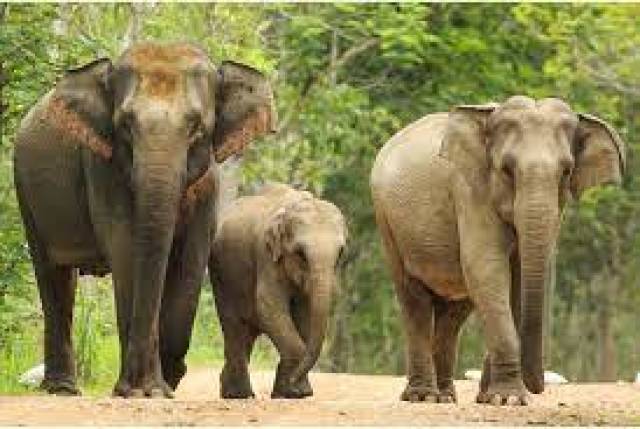The Asian elephant is the largest living land animal in Asia. Since 1986, the Asian elephant has been listed as Endangered as the population has declined by at least 50 percent over the last three elephant generations, which is about 60–75 years. It is primarily threatened by loss of habitat, habitat degradation, fragmentation and poaching. In 2019, the wild population was estimated at 48,323-51,680 individuals. Female captive elephants have lived beyond 60 years when kept in semi-natural surroundings, such as forest camps. In zoos, Asian elephants die at a much younger age; captive populations are declining due to a low birth and high death rate.
In general, the Asian elephant is smaller than the African bush elephant and has the highest body point on the head. The back is convex or level. The ears are small with dorsal borders folded laterally. It has up to 20 pairs of ribs and 34 caudal vertebrae. The feet have more nail-like structures than those of African elephants—five on each forefoot, and four on each hind foot. The forehead has two hemispherical bulges, unlike the flat front of the African elephant.
Asian elephants inhabit grasslands, tropical evergreen forests, semi-evergreen forests, moist deciduous forests, dry deciduous forests and dry thorn forests, in addition to cultivated and secondary forests and scrublands. Over this range of habitat types elephants occur from sea level to over 3,000 m (9,800 ft). In the eastern Himalaya in northeast India, they regularly move up above 3,000 m (9,800 ft) in summer at a few sites.
In China, the Asian elephant survives only in the prefectures of Xishuangbanna, Simao, and Lincang of southern Yunnan. Furthermore, in Bangladesh, some isolated populations survive in the south-east Chittagong Hills. A herd of 20–25 wild elephants was reported as being present in the Garo Hills of Mymensingh in the late-1990s, being detached from a big herd in the Peack hills of India and prevented from returning by fences put up in the meantime by the Indian border security force. The herd was estimated at about 60 individuals in 2014.



 Descargar Google Chrome
Descargar Google Chrome Descargar Mozilla Firefox
Descargar Mozilla Firefox Descargar Opera
Descargar Opera